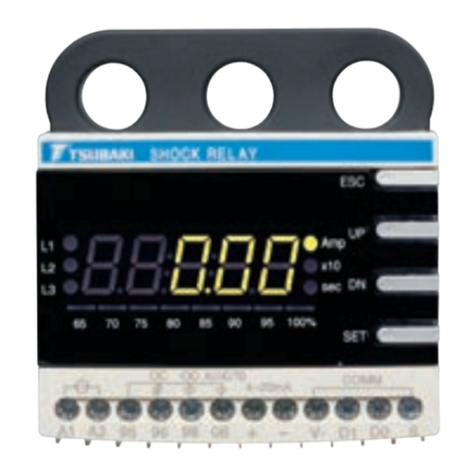
4. Specifications
Series TSB SA
Type Range
05 0.5 - 5A
10 1 – 10A
30 3 – 30A
Current Setting *
1
60 5 – 60A
Starting Trip Delay
Start Ti e 0.2 - 10s Ti e Setting *
1
Trip Ti e Shock Ti e
0.2 - 5s
Accuracy Current ±10% (full scale)
Control Power Supply 100~240VAC, 50/60Hz *
2
Rated Voltage 600VAC, 50/60Hz
Current Sensing 2 Integral Current Transfor er
Mode 1-SPDT(1-C)
Rating 3A / 250VAC, Resistive
Mini u applicable load *
3
DC10V, 10 A
Output Relay
Status Nor ally De-Energized
Mechanical 10,000,000 Operations Expected Output
Relay Life Electrical 100,000 Operations
Display Monitor(MON,green), Over Current(OC,red)
Reset Auto Reset after 1s
Operating -20 - +60℃ (-4 - +158 F) Te perature
Storage -30 - +70℃ (-22 - +176 F)
A bient Environ ent
Hu idity 45 - 85% RH without Condensation
Insulation Between casing and circuit Over 10MΩwith 500 VDC Megger
Between casing and circuit AC 2000V, 5 A, 60Hz, 1 in
Between contacts AC 1000V, 5 A, 60Hz, 1 in
Dielectric Strength
Between circuits AC 2000V, 5 A, 60Hz, 1 in
115VAC 2.70 VA(0.35W) Power Consu ption
230VAC 11.00 VA(1.2W)
Case Upper:PA6, Botto :PA66
Material
Ter inal cover PA6
Mounting 35 DIN rail or Panel
Di ension(WxHxD /Including Integral CT Windows) 54x60x65
Weight Less than 200g (0.445LBS) without External CT
*1 Current and ti e setting ranges can be set within the warranty range, but not the upper or lower
level of setting volu e.
*2 When Shock Relay Is used with Inverter, the output frequency of Inverter should be fro 30Hz
to 60Hz.
*3 When directly inputting output relay contact into the progra able controller (PLC), be aware
that a inute electric current can cause contact failure
.
As for the input to PLC, it is co ended
to drive the relay coil for inute current by relay signal of Shock Relay at first, then input this
relay contact to PLC.




























